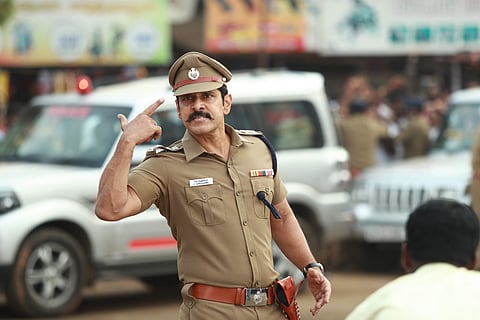Saamy Square Review: Saamy’s problems squared
Rating:(2 / 5)
Our filmmakers, it seems, are re-reading Ramayana. We got Kaala, which looked to subvert the traditional depiction of Ravana as an evil king. Walking out of Saamy Square, I couldn’t but wonder what Ranjith would make of Saamy Square, whose Ravana is painted in the darkest of blacks, and as a depraved man who’s not beyond having a pregnant woman go up in flames. It’s anybody’s guess why director Hari has taken inspiration from an epic for this sequel. I suspect it’s partly to try and imbue this film with a mythical quality.
Some of the original Saamy’s scenes have gone on to become part of our pop culture, and I realised with some surprise, the fondness I had for the 2003 film as rushes from that film got played during the title credits of Saamy Square. Be it the famous ‘Oruchchaami’ line, or his practice of crushing idlis in beer, the nostalgia of the first allows Hari to draw some easy applause by simply invoking those visuals. The birth of Aarusaamy’s son, Ramasaamy — I won’t ask you to note the obvious Rama prefix — seems like an exercise in masala mythmaking by itself. I won’t spoil it for you, but it’s an unforgettably gory idea.
Ramayana inspirations can be seen in the 28-year-long ‘exile’ of Ramasaamy in Delhi — twice as long as Lord Rama’s time. Perhaps they should have tripled the exile duration, so Vikram could actually look the part. Ravana Pichai (Bobby Simha does his darndest to make the character interesting) is shown to have lived his life mainly in Sri Lanka, and speaks that dialect too. Ravana Pichai also has two siblings (Ahiravana, Kumbakarna?), one of whom is played by John Vijay, whose biggest contribution is to open his eyes wide in horror as Ramasaamy bears down on him in contorted fury. Given how little he has to do in the film, perhaps the character is inspired by Kumbakarna, who is said to sleep on all but one day every year. Saamy Square is what Ramayana would have been, had Lord Rama wielded a pistol, been trigger happy and domineering. Of course, left to such filmmakers, Rama and Sita would likely have to dance in foreign locations to Devi Sri Prasad’s songs, and Lakshmana would, no doubt, get used as comic relief.
Adding to the efforts at mythmaking are the unintendedly hilarious scenes that show how Ramasaamy turns into a man possessed, upon any contact with a police uniform. At a wedding skirmish, a policeman is pushed, and Ramasaamy runs to help him. The moment he comes in contact with the man’s uniform, Ramasaamy crackles to life. He bellows; he hurls himself at his hapless enemies. He turns into a short-haired version of Anniyan. Later, when Ramasaamy steps foot in Tirunelveli — which apart from being known for its halwa, is also known for being the birthplace of His Holiness, Aarusaamy — a coconut crashes on the windshield of Ravana Pichai’s vehicle. Ravana’s left eye begins twitching to forebode ill fortune. He’s a superstitious man, and never forgets to seek advice from his mother, who rolls cowrie shells to foretell if the situation is conducive for her beloved son’s murderous tendencies. Let’s just say she, much like her kind, is not particularly good at her job.
Hari tries hard to raise the stakes for Ramasaamy, who has quite a few motivations to take down Ravana Pichchai including vengeance and justice. Unfortunately for Saamy Square, the problems of the first film — stalling songs, track comedy, dull conflict resolution — seem to have squared this time around, while the redeeming elements — quality of songs and humour, punch lines, mass moments — have fractioned. Take the Aarusaamy takedown scene, for example. You’d think it would take superhuman effort to bring down this seeming invincible cop, but it’s all accomplished fairly easily. While on lazy writing, it’s impossible not to discuss the portions featuring Soori. Each of those attempts at humour has him getting beaten up. One bit has him running around with a siren on his head, and someone uses the words, ‘Shakthimaan’ and ‘Sirenman’, in a sentence. Later, someone attempts to rhyme goorkha and oorga.
There’s a fair bit of inexplicable caste commentary that add nothing of value to this film — you could say this of all its Ramayana insprations too. A character expresses annoyance that caste is still a topic of conversation. Later, as Ramasaamy douses his idli in buttermilk, someone demands to know which caste he belongs to, and in true Hari style, we cut to a song about how he belongs to Police jaadhi. Saamy is shown being raised as a Brahmin, which means Vikram gets portions that let him channel his inner Ambi. In a seemingly momentous scene, his grandfather tells him it’s time to let go of his sacred thread, and to embrace his real identity. Later, Soori bizarrely trains everyone in Brahminspeak 101 in the name of comedy. It’s hard to tell if any of this is supposed to serve a bigger purpose.
As for Keerthy Suresh, Nadigaiyar Thilagam has spoiled us all, I think. It may forever be hard to not feel let down, every time she plays one of these characters that allow her very little wiggle room. In Saamy Square, she plays Diya, who falls in love upon getting rescued, as countless other Tamil heroines have. She also gets slapped about, and it all makes sense when you pay attention to a line she sings in the duet, Adhiroobaney: “Unai paarkumbothey bayam varum, needhaan aanin ilakkanam.” Suddenly, I understood why barely a few seconds after getting slapped by Ramasaamy, she smiles at him.
As for the other heroine, Aishwarya Rajesh, given the insignificance of her character’s scope in the film, they may as well have managed with Trisha’s portions from the first film. At least the universe would have felt more familiar, and the flashbacks more authentic.
Saamy Square is an attempt to leech off the first film’s iconic moments. It’s most evident when Ramasaamy, in a fit of inspiration, begins the famous line: “Oruchchaami… Renduchchaami…” After a while, he finally arrives at “Aaruchaamy!” But obviously, he’s not Aaruchaamy. So he continues, “…oda magan, Ramasaamy.” I burst out laughing. It summarises where this film stands in comparison with Hari’s 2003 film.

